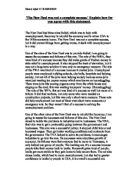Success: The New deal had many success stories. Many of the Alphabet Agencies were successes. The Public Works Administration (PWA) was a great success. It was set up to help ease the major problem of unemployment and also help the industry. It took a skilled work force to build things of actual use to the country that would last for a long time, bridges for example. Between 1933 and 1939, the PWA built 70% of America’s schools and 35% of America’s hospitals. It not only helped unemployment but also built things that were badly needed by society.
The Civilian Conservation Crops (CCC) also helped unemployment by taking jobless men to work in the country. This was also a great success. During the 1930s the CCC employed approximately 3 million men. This also helped farmers with problems such as soil erosion and the lack of trees.
The National Recovery Administratio0n was a great aid to hideously underpaid workers. It also helped put a stop to other evils such as child labour and long hours. This was also a great success.
If the New Deal were not a success in the early 1930s then Roosevelt would not have been re-elected in 1936. Roosevelt won in yet another landslide victory, this time it was even bigger than his annihilation of Hoover. This was just after the second New Deal had been drafted and presented to Americans. I think that morale had rise considerably in America as Americans did think that they were on the road back to prosperity. Up until that time Roosevelt had steered the aforementioned ship well. Some people did not agree with his policies, however they could not argue that thus far Roosevelt was doing a moderately good job, unemployment was dropping and the quality of life was on the up. The American people did not want to risk another president whilst things were looking steadily better. Also, there was not a great deal of opposition to Roosevelt and so not a great deal of choice for the American voter. However, things went downhill after this great high, Roosevelt continued to argue with the Supreme Court and the Spirit of Reform was never recovered. Depression and War loomed large.
Failures: If the First New Deal was such a great success in the first place then why was a second New Deal put into place? It looked to most Americans that Roosevelt was the hero who was guiding them out of trouble, but Roosevelt had great opposition, most of all in the form of the Supreme Court who did not agree with the New Deal. Republicans who seemed to be determined to make things as difficult as possible for Roosevelt and his New Deal dominated the Court. The Supreme Court was very powerful and it could over turn laws, which were unjust. In May 1935 the Court ruled that the government could not prosecute The Schechter Poultry Commission for breaking the NRA. The Court undermined Roosevelt’s authority with the ruling. The Commission had in fact broken the law, but the Court did not agree with the law and so decided to over rule the government. This outraged Roosevelt. He requested to Congress that he should appoint six more judges that would be more sympathetic to the New Deal. However, the American people saw him to be attacking the American law system. He had to back down and his plan was rejected. Even so the Court was less disruptive in the future and from 1937 onwards approved most of his Second New Deal.
Farmers were strongly for the New Deal as the Agricultural Adjustment Act paid them for doing, well, nothing. They were paid compensation not to produce crops as over-production kept prices too low. This did make prices rise, however many people felt that it was a waste of good money to give to farmers for not producing. It was also seen to be destroying other people like businessmen.
Many high-profile figures argued that the New Deal was not doing enough to help the poor people of America. One of these figures was Huey Lung. He became Governor of Louisiana in 1928 and Senator in 1932. He helped the poor by taxing large companies and used the money to build hospitals and roads. He employed poor black people who badly needed the work and the money. Black people were employed on the same terms as whites and he clashed with the Ku Klux Klan. He felt that Roosevelt should be fairer towards the blacks and battle with problems, such as racism.
Small farmers did not benefit as largely as large-scale farmers. Small farmers and farm labourers were not helped by the drastic measures introduced by Roosevelt. There was still a great deal of poverty in Rural America.
The New Deal was a success. Although it all went wrong again in 1937 the New deal did achieve what it set out to do. It got the United States out of depression, all be it for a short time before the slump of 1937.
The New Deal was not a ‘complete success,’ as there were a few hiccups along the way. To go back to the ship analogy, Roosevelt steered the ship out of trouble and back to port without hitting too many ice burgs and stayed out of serious trouble. However, once the ship was safely back to port all the good work was undone when the ship sinks, this reflects the 1937 recession.







